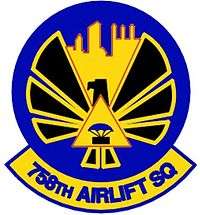758th Airlift Squadron
| 758th Airlift Squadron | |
|---|---|
|
758th Airlift Squadron Patch | |
| Active |
19 May 1943 – 28 August 1945 12 July 1947 – 27 June 1949 16 November 1957 – present |
| Country | United States |
| Branch | United States Air Force |
| Type | Airlift |
| Part of |
Air Force Reserve Command 22nd Air Force 911th Airlift Wing 911th Operations Group |
| Garrison/HQ | Pittsburgh International Airport |
| Decorations |
Distinguished Unit Citation Air Force Outstanding Unit Award Republic of Vietnam Gallantry Cross with Palm |

The 758th Airlift Squadron (758 AS) is part of the 911th Airlift Wing at the Pittsburgh International Airport, Pennsylvania. It operates the C-130H2 version of the C-130 Hercules aircraft, providing global tactical airlfit.
Mission
To organize, recruit, and train Air Force Reserve personnel to provide airlift of airborne forces, their equipment and supplies, and delivery of these forces and materials by airdrop, landing, or cargo extraction systems.
History
Activated as a B-24 Liberator heavy bombardment squadron in July 1943; assigned to II Bomber Command for training. Primarily trained in Utah and Arizona received deployment orders for the Mediterranean Theater of Operations (MTO) in September 1943. Moved to Massachusetts where the group flew long-range convoy escort missions over the Newfoundland Banks to Long Island Sound, November–December 1943 while station in Italy was being constructed.
Deployed to Southern Italy in January 1944; entered combat in February, being assigned to Fifteenth Air Force. Engaged in very long range strategic bombing missions to enemy military, industrial and transportation targets in Italy, France, Germany, Austria, Hungary, Romania, and Yugoslavia, bombing railroad marshalling yards, oil refineries, airdrome installations, heavy industry, and other strategic objectives. Also carried out some support and interdiction operations. Struck bridges, harbors, and troop concentrations in August 1944 to aid the invasion of Southern France. Hit communications lines and other targets during March and April 1945 to support the advance of British Eighth Army and American Fifth Army in northern Italy.
Returned to the United States in August 1945, being programmed for deployment to the Pacific Theater of Operations (PTO) as a B-29 Superfortress Very Heavy Bombardment Squadron. Many combat veterans of MTO demobilized upon arrival in the United States, and a small cadre of personnel reformed at Sioux Falls Army Airfield, South Dakota at the end of August. Japanese Capitulation in August led to inactivation of unit and assigned personnel being reassigned to other group squadrons or demobilized.
Reactivated in the Air Force Reserve in 1947 with B-29s. Trained at Long Beach Army Air Field, California then inactivating.
It has provided air transportation for airborne forces and worldwide airlift operations since 1957.
Lineage
- Constituted 758th Bombardment Squadron (Heavy) on 19 May 1943
- Activated on 1 July 1943
- Redesignated 758th Bombardment Squadron, Heavy c. Sep 1944
- Inactivated on 28 August 1945
- Redesignated 758th Bombardment Squadron, Very Heavy on 13 May 1947
- Activated in the Reserve on 12 July 1947
- Inactivated on 27 June 1949
- Redesignated 758th Troop Carrier Squadron, Medium on 24 October 1957
- Activated in the Reserve on 16 November 1957
- Redesignated: 758th Military Airlift Squadron on 1 January 1967
- Redesignated: 758th Tactical Airlift Squadron on 1 March 1972
- Redesignated: 758th Airlift Squadron on 1 February 1992.
Assignments
- 459th Bombardment Group (1943–1945, 1947–1949)
- 459th Troop Carrier Wing (1957–1963)
- 911th Airlift Wing (1963–present)
Stations
|
|
Aircraft operated
- B-24 Liberator (1943–1945)
- T-6 Texan (1947–1949)
- T-7 Navigator (1947–1949)
- T-11 Kansan (1947–1949)
- C-119 Flying Boxcar (1957–1967)
- C-124 Globemaster II (1966–1972)
- C-123 Provider (1972–1980) In June 2015, the Department of Veterans Affairs determined that some of the C-123 aircraft operated by the 758th TAS exposed crewmembers and maintenance staff to residual Agent Orange toxins, and veterans of the period are qualified for Agent Orange benefits if suffering any of the associated illnesses.
- C-130 Hercules (1980 – present)

